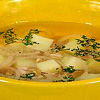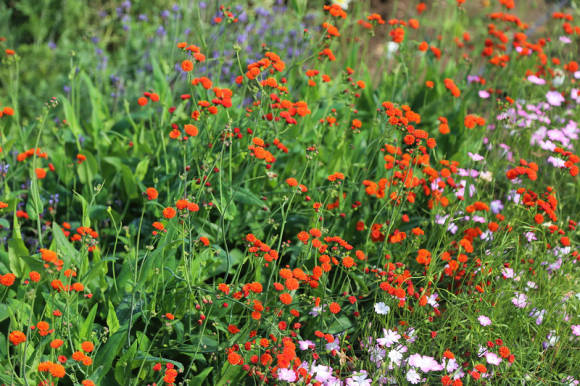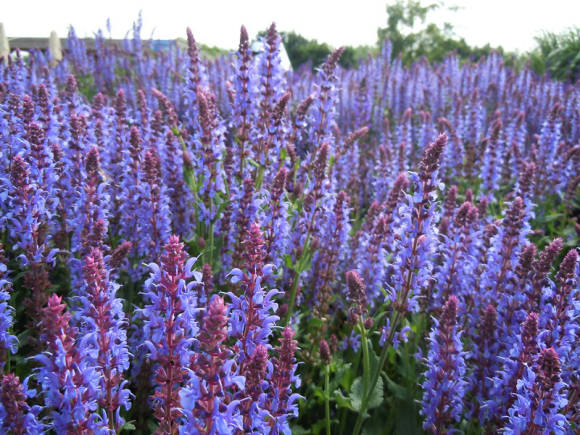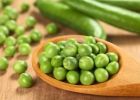 Recently, more and more often on their plots, flower growers, along with "alpine slides", arrange decorative reservoirs, trying to beautifully arrange even a small pond. However, they often strive to plant as many plants as possible in the water. As a result, among the dense thickets and the abundance of foliage, the water mirror is almost invisible. Meanwhile, one must remember that in such compositions, the main decorative element is precisely the open water surface. Plants should occupy no more than 30-40% of the surface of the reservoir.
Recently, more and more often on their plots, flower growers, along with "alpine slides", arrange decorative reservoirs, trying to beautifully arrange even a small pond. However, they often strive to plant as many plants as possible in the water. As a result, among the dense thickets and the abundance of foliage, the water mirror is almost invisible. Meanwhile, one must remember that in such compositions, the main decorative element is precisely the open water surface. Plants should occupy no more than 30-40% of the surface of the reservoir.
An artificial reservoir can be made in a formal or landscape (natural) style. The first assumes a geometrically correct outline of the reservoir (circle, rectangle, etc.) and clearly defined boundaries. No plants are planted on its banks. In the garden, the “formal” body of water is positioned in such a way that attention is focused on it. To do this, it must be separated from other elements of the garden by lawns. For greater effect, special technical devices are often used - fountains, lighting.
The reservoir, decorated in a landscape style, has a free outline. The smooth coastline is necessarily decorated with coastal plants. The creation of such a reservoir is less laborious. In addition, it does not need to be separated from other elements of the garden, which is difficult to do in a small area. The landscape style provides ample opportunities for the use of plants of natural flora when decorating a reservoir. Therefore, knowledge of the basic laws of the life of aquatic plants in natural conditions will allow you to avoid mistakes and create a harmonious ensemble without unnecessary expenditures of time, effort and money.
In natural plant communities (phytocenoses), in the process of evolution, plant species have been selected that are adapted to coexistence in these conditions. The peculiarity of the natural environment determines the appearance and biological characteristics of aquatic and coastal plants. Higher plants "leading an aquatic life" take root at different depths. In this regard, a pronounced zonation of vegetation is observed near the shores of the lakes. The following main belts are distinguished here.
Free floating plants (not attached to the bottom of the reservoir) are divided into two groups. The first includes submerged species that do not appear on the surface of the water - hornwort (Ceratophillum demersum), pemphigus vulgaris (Utricularia vulgaris). These plants do not have roots, they absorb water with dissolved elements of mineral nutrition and oxygen throughout their entire surface, which is significantly increased by feathery, strongly dissected leaves. In books on landscape design, dedicated to the arrangement of garden ponds, representatives of this particular group are called "oxygenators", although, strictly speaking, all green plants in the light in the process of photosynthesis release oxygen.
 |  |
Hornwort ordinary | Pemphigus common |
Representatives of another group swim on the surface of the water: small duckweed (Lemna minor), ordinary water paint (Hydrocharis morsus-ranae). This also includes an ordinary teloresis (Stratoides aloides) with half-submerged rosettes of rigid, serrated leaves along the edges.
 |  | |
Duckweed | Vodokras ordinary | |
 | ||
Telorez ordinary | ||
The second belt is made up attached plants with floating leaves to the bottom of the reservoir. These are some types of rdestov, for example, floating rdest (Potamogeton natans), egg capsule yellow (Nuphar lutea), white water lilies (Nymphaea candida) and white (Nymphaea alba). The latter species in the Moscow region remains viable even in freezing water bodies. Due to the deficiency of oxygen in their habitat, these plants are characterized by variegation (heterophyllia) - underwater and emergent leaves are very different. The first are narrow, often with strongly reduced plates; the latter are on long petioles, with wide leaf blades lying on the surface of the water.A powerful system of gas exchange air cavities also helps these leaves to stay afloat.
 |  |
Rdest floating | Yellow capsule |
 |  |
White water lily | White water lily |
The third belt is formed coastal ("Amphibious") plants that take root at different depths and rise significantly above the water surface. Often these plants can develop outside the water, in highly humid places - damp meadows, low-lying swamps, in wetlands. Lake reeds come to a depth of more than 1 m (Scirpus lacustris), common reed (Phragmites communis), broadleaf cattail (Typha latifolia). Due to intensive vegetative reproduction, they form extensive thickets - floodplains. As these plants die off, reed or reed peat accumulates, which in a closed reservoir can lead to gradual waterlogging.
 |  |  |
Bulrush | Common reed | Rogoz broadleaf |
Large manna lives in shallow water (Glyceria maxima), marsh iris (Iris pseudacorus), calamus (Acorus calamus). Calamus cereal is very decorative (Acorus gramineus) - a small narrow-leaved plant that looks like a cereal. Umbelliferae also grows near the coast. (Butomus umbellatus), plantain daisy (Alisma plantago-aquatica), arrowhead (Sagittaria sagittifolia).
 |  | |
Susak umbrella | Calamus cereal | |
 | ||
Mannik big | ||
On the banks of water bodies there are plants that do not belong to the water itself, but need high soil moisture - marsh calla (Calla palustris), marsh marigold (Caltha palustris) and others, swamp forget-me-not (Myosotis palustris), many types of rushes (Juncus spp.) and sedge (Carex spp.). These plants, typical of lowland bogs and marshy meadows, are perfect for decorating the shores of a landscape garden pond.
 |  |
Forget-me-not swamp | Marsh marigold |
 | |
Calla swampy | |
When creating a reservoir, it is advisable to find a place for representatives of different belts, if, of course, the area and depth allows. In natural communities, all components of the system are in a state of dynamic equilibrium with each other and with the environment. An imbalance will inevitably lead to a shift in balance. So, in the absence of submerged plants in the reservoir, a rapid growth of algae begins - the water becomes cloudy. Quantitative imbalances are no less dangerous. If more than half of the surface of the reservoir is covered with floating leaves of water lilies, then the submerged plants will not have enough light. In a reservoir with an area of 5 m2 and a maximum depth of 0.6 m, it is enough to plant 1-2 water lilies, 10 submerged and 5-7 coastal plants. Do not forget that many aquatic and bog species are distinguished by intensive vegetative reproduction. Therefore, it is better to plant them in lattice plastic containers. In addition, specially bred compact varieties can be used: they are more decorative and, as a rule, grow more slowly.
However, many growers densely plant the space around the water with decorative perennials - hosts, daylilies, badan, etc. As a result of this "mixing of genres", the entire effect of the reservoir, decorated in a landscape style, disappears. It is better to arrange a shady garden nearby - but as an independent object (for example, separating it with a path). These and many other moisture-loving plants can be freely placed there - bathing suits, primroses, astilbe, aquilegia. A well-planned and executed pond of free outlines is the decoration of any garden. The main thing when creating it is not to forget the basic principle: "less is better."
K. Golikov,candidate of biological sciences,Botanical Garden of Moscow State University M.V. Lomonosov









